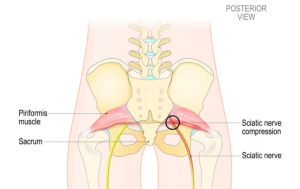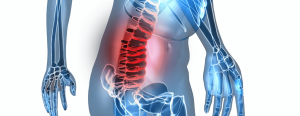Sciatica
Can your sciatic nerve cause abdominal pain

How Your Sciatica Nerve Can Cause Abdominal Pain
A person may experience abdominal pain due to sciatica, which is caused by the compression of a nerve in the lower back. The symptoms of sciatica can be both temporary and permanent. This article will discuss abdominal pain as a symptom of sciatica and other possible sciatica causes that may include abdominal pain and abdominal bloating.

Where Is Sciatic Pain Typically Felt?
An individual suffering from sciatica feels pain due to radiating along the sciatic nerve. It starts from your lower spine and travels to the back of your leg and down the buttocks. Various problems in your lower back can cause the sciatic nerve to become irritated or pinched, which then causes nerve pain in these areas.
The pain is generally felt in one leg only. Sciatica symptoms include a type of pain that may be searing or sharp. Burning pain is also a type of pain possible.
You will experience different kinds of muscle pain, lower back pain, upper back pain, neck pain, or arm pain, depending on where your sciatica is located. Different nerve roots produce other sensations and different pain signals based on location.
Sciatica is most commonly associated with the lumbar spine and sacrum. The source of your sciatic pain will create slightly different symptoms from each other.
L4 Nerve Root
Pain in the hips, thighs, inner knees, calves, and feet may be caused by irritation to the L4 nerve root. The thighs and hips may feel weak, and the calves may feel numb. People often wonder, does sciatica cause knee pain.
If sciatica is at the L4 level, the person may lose the ability to bend their foot or walk on their heels, and their knee-jerk reflex may be decreased.
L5 Nerve Root
People suffering from sciatica from the L5 nerve root commonly experience pain in their legs, buttocks, and outer thighs, as well as difficulty lifting their big toe. Usually, the most prominent toe and the second toe are numb in cases of sciatica at the L5 level.
S1 Nerve Root
Typically, sciatica caused by the S1 nerve root is known as classic sciatica since the root is located in the sacrum. When the S1 level of the spinal column is affected, the buttocks, back of the calf, and outside of the foot are most affected.
The third, fourth, and fifth toes may also be numb or tingling in individuals with sciatica from the S1 level.
They may also find it difficult to walk on tiptoes or lift their heels when their heels hit the floor. People with this disorder may also have weakened ankle-jerk reflexes.
Are There Conditions That Can Feel Like Sciatica Pain?

Spinal arthritis, degenerative disc disease of the lumbar spine, and osteophytes are the conditions that are likely to cause sciatica. However, other conditions can cause symptoms similar to sciatica. Among them are piriformis syndrome and sacroiliac joint dysfunction.
Can Sciatica Pain Be Felt in Abdomen?
Does sciatica cause abdominal pain? There are cases when sciatica can lead to abdominal pain, even though it is rare. The pain is usually felt in the lower abdomen near the pelvis.
Musculoskeletal chronic pelvic pain is often caused by pressure on the pelvic nerves, pelvic and hip bones, and pelvic floor muscles.
Symptoms of chronic pelvic pain include both sciatica and abdominal pain. In addition, this condition may also cause chronic low back pain, radiating pain, chronic pain, upper back pain deep pelvic pain, pudendal neuropathy, sacroiliac inflammation, and muscle weakness and spasms.
Can a Herniated Disc Cause Abdominal Pain?
Yes, it can, but it is not common. Lateral disc herniation is a type of herniated disc that can lead to abdominal pain. A thoracic herniated disc that herniates lateral, or on one side, is more likely to press against the nerve root that exits at that level of the spine and cause radiating chest wall pain or abdominal pain.
It is common for a thoracic disc herniation to be asymptomatic or for patients to complain of nonspecific symptoms, like chest wall pain, abdominal pain and upper extremity pain. In some cases, pain in the lower extremity or groin is also experienced.
Symptomatic thoracic discogenic pain syndrome (TDPS) is a rare occurrence that can be difficult to diagnose.
What Causes Sciatica Pain?
Lumbar Herniated Disc
A lumbar herniated disc occurs when the rubbery disc between the vertebrae of the lower back bulges or ruptures, causing irritation and compression of the spinal nerve roots. The most common cause of sciatica is a bulging disc or herniated discs.
Degenerative Disc Disease
A vertebral disc may begin to wear out with age as a result of degenerative disc disease. A thin disc causes the space between each vertebra to compress, causing the sciatic nerve root to be compressed.
A disc with a worn outer covering may leak fluid out onto the sciatic nerve and irritate it.
Bone Spurs
Overgrowth of bone (osteophyte) on vertebrae can cause sciatic pain. The bone spurs usually form near vertebrae affected by osteoarthritis.
Spinal Stenosis – Spinal Discs
A narrowing of the spinal canal and the sciatic nerve roots is caused by spinal stenosis. Arthritis and aging can contribute to the narrowing of the arteries.
Spondylolisthesis
Anatomically, vertebrae are stacked one onto the other to provide stability. Spondylolisthesis occurs when one vertebra slips forward over the one below it and presses into the sciatic nerve.
Piriformis syndrome
Piriformis syndrome refers to irritation of the sciatic nerve caused by too tight piriformis muscles and muscle weakness. If you sit for a long time, walk upstairs, run, or walk for a long time, the symptoms may worsen. The piriformis muscle extends from the top of the thigh bone to the sacrum (the triangular bone below your spine).
Can Sciatica Nerve Affect Bowel Movements?
Yes, it does. Sciatica pain can affect bowel movements. It is usually caused by a syndrome called cauda equina.
Cauda equina syndrome results from compression of nerves along the spine’s lateral side. Almost any condition that results in direct irritation or pinching of the lower spinal cord nerves can cause cauda equina syndrome.
Aside from the inability to control bladder and bowel movements, symptoms of cauda equina syndrome include low back pain, numbness and tingling in your legs and buttocks (sciatica), weakness in your legs, and abdominal pain.
How to Treat a Sciatica and Abdominal Pain? Treatment Options
After your doctor diagnoses sciatica, you will likely receive tips on how to treat your chronic pain. It is crucial that you continue to go about your daily activities. Your condition can worsen if you stay in bed or avoid physical activity.
To start with medical treatment, it is essential to know what’s causing pain, identifying risk factors, and prevent symptoms from becoming a medical emergency. Treatment options may vary.
Cold Compress
Using ice packs or frozen vegetables is an option.
For the first few days of pain, wrap an ice pack or frozen vegetables in a towel and apply it to the affected area for 20 minutes each day, several times a day. As a result, swelling will be reduced, and nerve pain will be eased.
Hot Compress
A heating pad or a hot pack can also be purchased.
During the first few days, it’s recommended that you use ice to reduce swelling. During the second or third day, switch to heat. In the case of persistent pain, alternate heat and ice therapy.
Stretching
Likewise, stretching your low back can be beneficial. Physical therapists or yoga instructors who deal with sports injuries can give you one-on-one guidance on how to stretch correctly and provide physical therapy if needed.
Regular exercise
Your body releases endorphins more when you stay active. Your body makes endorphins, which are pain relievers.
At first, limit your activities to low-impact exercises, such as brisk walking and stationary cycling.
Develop a workout regimen that combines aerobics, strength training, and core stability as your pain decreases. This kind of regimen can help you avoid future back pain problems.
Over-the-counter medication
A nonsteroidal anti-inflammatory drug such as aspirin and ibuprofen, which are available over-the-counter, can also relieve pain, inflammation, and swelling. Avoid excessive use of aspirin since it can cause stomach bleeding and ulcers.
Epidural steroid injections
Medications containing corticosteroids are injected into an area surrounding the spinal cord known as the epidural space. There are side effects associated with these injections, so they are given only occasionally.
Prescription medication
Your doctor might prescribe antidepressants, muscle relaxers, and narcotic pain medications. Taking tricyclic antidepressants can increase your body’s production of endorphins.
Surgery
If you’re suffering from severe pain or have lost control of your bowels and bladders, or have developed weakness in specific muscles of your lower extremities, surgery may be necessary.
A diskectomy removes the part of the disk pressing on the nerves making up the sciatic nerve. On the other hand, microdiscectomy removes the disk by using a microscope to make a small cut while your doctor removes the disk from the inside.
Red Flags on sciatica symptoms
- arm pain
- spinal discs pain
- spinal nerve severe pain
- neck pain
- lower back pain
- bowel or bladder pain
- muscle spasms
- peptic ulcers
- abdominal bloating
- bloating and back pain
- prolonged sitting
- leg pain
- pain that radiates down back and legs
- muscle strain
- poor posture
- pinched nerves
Conclusion
Sciatica pain is usually in the lower part of the body, but little is known whether it can cause stomach pain.
Sciatica is already known to cause radiating pain in the lower limbs. At times, sciatica can also cause hip pain due to pinched nerves. But stomach pain is not usually a common symptom of sciatica. However, pain symptoms in the abdomen can indeed be caused by sciatic nerve irritation.
Medical conditions such as stomach ulcers, menstrual cramps, rheumatoid arthritis, muscle tension, ovarian cysts, and nerve compression in the abdominal wall are just a few conditions that can cause pain in the pelvic region or abdomen. When pain is experienced, it would be best to consult a physician to know the cause of the pain.
When sciatica starts causing stomach pain, immediate medical attention is needed, especially if the pain has continued for a few weeks. If left untreated, it can cause a loss of bowel control and become a medical emergency that does require immediate medical attention.
To treat abdominal pain brought by sciatica, it is essential to know what is causing sciatica and start treatment from there.






















